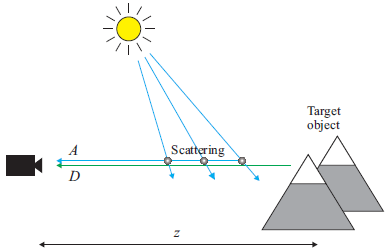
|
Home Publications York Polarisation Photometric stereo Q-Bot Composites Theory 1 Theory 2 Theory 3 Theory 4 Outdoor and underwater polarisation imagingOne of the most common causes of polarization in nature is atmospheric scattering. Consider the imaging process of a distant outdoor object or scene. Light that arrives at a detector consists of a component transmitted from the object itself, D, and a component of "airlight", A. The former of these is typically reflected sunlight while the latter is light scattered from the atmosphere, as shown in the figure below:
The total intensity at the camera can be represented by:
It can be shown [1] that
where A∞ is the airlight radiance for an object at infinity, Lobj is the object radiance, z is the distance to the object and t(z) is given by
where β is called the coefficient of extinction. As explained in the Polarization entry, atmospheric scattering causes polarization. The degree of polarization for the airlight component is be given by
where A⊥ and A|| are the scattered components parallel to, and perpendicular to, the plane of scattering respectively. If it is assumed that the target object is emitting/reflecting unpolarized light, then the light measured through a linear polarizer is a transmitted radiance sinusoid, but with an intensity offset equal to the light directly transmitted from the target object. Clearly, the simple task of rotating a lens-mounted polarizer to the angle that allows minimum transmission removes some of the airlight and so enhances the image of the target object. Taking images at more than one polarizer orientation allows to solve for the unknowns in the above equations and dehaze an image more effectively [1]. A related polarization analysis can also be used for images taken in murky water [2]. References[1] Schechner, Y.Y., Narashimhan, S.G., Nayar, S.K. (2003). Polarization based vision through haze. Applied Optics 42, 511-525. [2] Schechner, Y.Y., Karpel, N. (2005). Recovery of underwater visibility and structure by polarization analysis. IEEE J. Oceanic Engineering 30, 570-587. |




